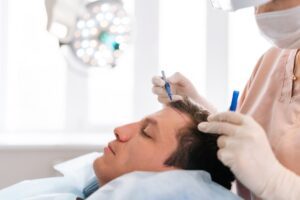Dr Ariel N. Rad is a leading Board certified plastic surgeon known for his precise, evidence-based approach to facelift and aesthetic medicine.
He built his career on disciplined training, scientific rigor, and a belief that natural results come from deep understanding rather than trends. After completing his residency at Johns Hopkins, he co-founded SHERBER+RAD in Washington, D.C. with his wife, dermatologist Dr Noëlle Sherber. Together, they created one of the first fully integrated practices combining dermatology, facial aesthetic surgery, and curated skincare under one roof.
Dr Rad has performed more than 3,000 facelifts using refined deep-plane and endoscopic techniques. His early work in microvascular reconstructive surgery shaped his respect for anatomy, meticulous attention to detail and long-term function. He often says, “You cannot force beauty; you reveal it,” a philosophy that guides his decision-making in surgery and patient care.
Instead of chasing fads, Dr Rad focuses on education, ethics, and safety. He is known for turning patients away when a request does not serve their wellbeing. He performs all surgical procedures in hospital-based settings, emphasizing that “safety is not optional.”
His clients include high-profile professionals, diplomats and global travellers who value discretion, honest guidance and believable results. Word of mouth has fuelled the growth of SHERBER+RAD since 2014, reflecting the trust he has built through consistency and expertise.
Dr Rad continues to advocate for higher standards in aesthetic medicine, stressing the importance of board-certified training, responsible technique and patient-centered care. His career remains grounded in the principle that excellence is a habit built through integrity, collaboration, and lifelong learning.
Q&A With Ariel Rad
You trained at Johns Hopkins. How did those years shape your approach to facial surgery?
My time there taught me discipline above all else. At Hopkins, excellence was treated as a daily habit. We were taught to master fundamentals before anything else. That mindset stayed with me. It also exposed me to microvascular reconstructive surgery, which demanded precision and respect for anatomy. Those experiences shaped how I operate today.
You began in reconstructive work before focusing on aesthetic surgery. What did you take from that early chapter?
Reconstructive work teaches you humility. From a technical standpoint, if a blood vessel connection is one millimeter off, the entire operation can fail. You learn that you cannot rush anything. And when you restore form and function for patients recovering from cancer, you see how important structure is.You learn to work with the tissue, not against it. That discipline forms the basis of everything I now do in facial rejuvenation.
In 2014, you and Dr Noëlle Sherber opened SHERBER+RAD. What was the vision behind the practice?
We wanted a practice that felt coherent. Dermatology, surgery and skincare are often treated as separate worlds, but they are deeply connected. We wanted a place where everything worked together for the patient’s long-term benefit. We designed private cabanas, a confidential entrance, and a flow that allows for calm and privacy. Every detail was intentional.
Your work is known for natural results. How do you achieve that?
For me, a natural result comes from respecting the anatomy. I have performed more than 3,000 facelifts using deep-plane and endoscopic methods. Those techniques allow us to work beneath the surface, where the real support structures are. If you treat the deeper layers properly, the face moves naturally. You do not see the “pulled” look people fear.
You’ve said, “Good surgery does not announce itself.” What do you mean by that?
Good surgery should let people feel like themselves. It should not draw attention. When someone tells me their friends say they “look rested” or “look well,” that is the best feedback. Surgery should support identity, not replace it.
Your practice has grown through word of mouth rather than heavy marketing. Why take that path?
Trust cannot be manufactured. It is earned. We focus on evidence-based care, and we turn away requests that do not align with safety or natural outcomes. Patients value honesty. Growth happened because people appreciated that approach and shared their experiences with others.
What do you think people misunderstand most about aesthetic medicine today?
People underestimate the complexity. Social media makes procedures look simple, but the face is an intricate structure. Every decision has long-term implications. Aesthetic medicine is real medicine. It requires training, ethics and careful judgment.
With more than 3,000 facelifts performed, what has experience taught you?
Consistency matters more than anything. Each case is individual, but the principles never change: respect anatomy, plan carefully, work methodically, and prioritize safety. Experience deepens your judgment. You learn when to operate — and when not to.
What advice do you give people considering aesthetic surgery?
Ask about training. Verify board certification. Make sure your surgeon operates in accredited, hospital-based facilities. And take your time. These choices should not be rushed. If something sounds too good to be true, it usually is.
What continues to motivate you after two decades in the field?
Helping people feel more confident in themselves. That is meaningful work. And teaching — I enjoy sharing what I have learned and advocating for higher standards in our field. The industry advances when we prioritize safety, evidence and integrity.
For more on his approach to facial surgery, visit Ariel Rad.
38 year old woman 2 months after endoscopic brow lift, canthoplasty (outer eye corner lift), deep plane face lift, deep structural neck lift, porous polyethylene orbital rim implants, lower blepharoplasty, microfat grafting.

